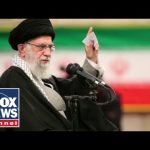In a dramatic twist of events, the United States has executed a powerful military operation against Iran, targeting major underground nuclear facilities. According to recent reports, President Biden confirmed that a total of six intense 30,000-pound bunker buster bombs were unleashed on the Fordow facility. This facility, which lies deep within the mountainside and was feared to be indestructible without nuclear force, has reportedly been obliterated. This massive airstrike utilized advanced B-2 bombers that were likely darting in from a tactical direction, showcasing the precision and strength of American military capabilities.
The strategic planning behind this operation appears to be intricate and highly calculated. It is estimated that at least three B-2 bombers were involved in delivering these bunker buster bombs, which can penetrate up to 200 feet underground. The nature of the bombing indicates that the initial explosions created holes around 25 feet in radius, making it possible for subsequent ordnance to strike directly and deepen the destruction. This multi-layered approach likely ensured that both entrances of the facility were compromised, resulting in a significant blow to Iran’s nuclear ambitions.
In addition to the successful strikes on Fordow, Tomahawk missiles were launched from U.S. submarines, extending the reach of the American military’s strike force. This operation not only targeted the Fordow site but also aimed at other locations like Natanz and Isfahan, ensuring that the Iranian nuclear program suffered massive blows across multiple fronts. The involvement of warships from aircraft carrier strike groups, including the USS Vincent and the newly arrived USS Nimitz, demonstrated just how prepared the U.S. Navy is to respond to threats in this region.
With 40,000 U.S. troops now put on high alert across the Middle East, tensions are mounting. Military officials are preparing for potential retaliation from Iran, which may come in the form of missile attacks on U.S. bases or other military assets. Despite the gravity of the situation, the U.S. is hopeful. There is a sentiment that if Iran is smart, it might choose to negotiate rather than escalate further.
As the dust settles from this recent military maneuver, it becomes evident that the stakes are significantly high for both nations. President Biden has emphasized that the conflict is not against the people of Iran, but rather against their government’s pursuit of nuclear weapons. The message is clear: the U.S. will not tolerate such threats and is more than capable of responding decisively. However, the onus now rests on Iran to think strategically about its next move. Will they choose to escalate or engage in dialogue? The international community is watching closely, waiting to see what unfolds next.




